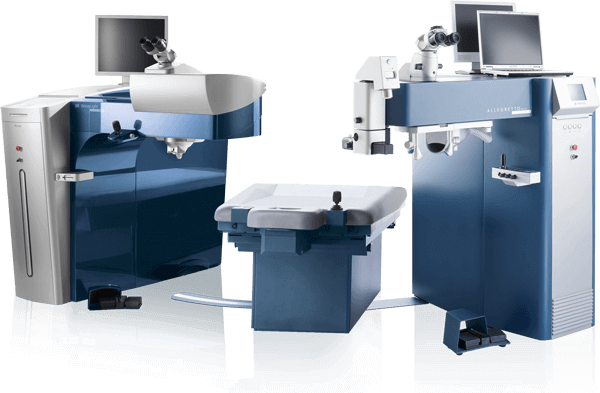LASIK is a brief outpatient procedure that can significantly lessen dependence on corrective lenses. LASIK brings together the science of the Excimer laser and the skill of the surgeon to correct nearsightedness, farsightedness and astigmatism.
The Wheaton Eye Clinic is committed to the highest standards of patient care in laser vision correction and has a long history of excellence performing refractive procedures to help patients reduce, or eliminate, their need for corrective eyewear.
The highly skilled surgeons at Wheaton Eye Clinic have been performing laser vision correction since 1997. They have helped thousands of patients achieve freedom from glasses and contacts and are at the forefront of the latest technological advancements.

Today, Wheaton Eye Clinic utilizes the WaveLight EX500 Excimer Laser and the WaveLight FS200 Femtosecond Laser to produce an excellent visual outcome that is customized to a patient’s own personal vision requirements This unique, individualized laser treatment offers every patient an unparalleled level of safety, precision, and accuracy.
Some people encounter situations in which the condition or the shape of the eye makes them a poor candidate for LASIK correction. PRK, or Photorefractive keratectomy, may be recommended by your surgeon as an alternative to LASIK. PRK has been shown to have the same success rate as LASIK and differs from LASIK in that a flap is not created prior to treatment with the Excimer laser. There is no cutting of the cornea, therefore, all the potential problems with flap formation and healing are eliminated. The customized laser correction—Wave-Front Technology—can also be used with PRK.
Similar to PRK, a procedure called LASEK works without the need for cutting with the laser. Instead, a solution is applied to the eye's exterior, allowing the doctor to move the epithelium (outer layer), perform the laser correction, and then slide the epithelium back into place. The procedure is quick and allows for fast healing.
Which procedure is best for you will be a decision made by you and your surgeon at the time of consultation after a thorough discussion of the risks and benefits of each procedure.
Critical to excellent visual outcomes is the expertise and meticulous attention to detail controlled directly by your surgeon and the surgical team during your procedure. You will spend significant time with your surgeon during the consultation and have all questions answered before proceeding to a treatment plan that is right for you.



Frequently Asked Questions (FAQs) give quick and easy answers to the questions we are asked most often by patients and their families.
The name “LASIK” is short for Laser Insitu Keratomileusis. LASIK reshapes the cornea with excimer laser technology. The shape of the cornea is what determines whether you are nearsighted, farsighted, have astigmatism or have normal vision. The Excimer Laser emits a “cool” laser light that can remove microscopic amounts of tissue with extreme precision. Physicians can program the laser to sculpt the cornea.
Even though LASIK is a relatively safe procedure with a history of very few complications, these risk factors should be considered:
Certain temporary side effects can be expected as part of the recovery process:
As people approach their mid-forties, it is natural for them to begin losing their ability to focus on both near and distant objects. This age-related change is called presbyopia. It is the result of the lens in the eye becoming less elastic and losing its ability to change its focus.
Age-related focusing problems are usually relieved by reading glasses or bifocal lenses. People with low amounts of nearsightedness can simply remove their glasses and read. Contact lens wearers can use reading glasses over their contacts. Another contact lens option is to wear one lens for near vision in one eye and another corrected for distance vision in the other eye. This is known as monovision.
Monovision may also be an option for those considering refractive surgery. The advantage of monovision is the ability to both read and see in the distance without corrective lenses. This option might be particularly helpful for people who frequently shift their vision between near and far distances. If you feel monovision may be an option for you, it is important to approach it with care. We recommend trying it with contacts before proceeding with surgical correction. Wearing these specially prescribed contacts for several days will give you the opportunity to try monovision to help determine whether it is right for you.
Prior to your procedure, you will need to have a comprehensive evaluation by your surgeon at Wheaton Eye Clinic. A comprehensive exam includes:
After your exam, the doctor will review the risks, benefits and goals of laser vision correction to make sure your expectations are achievable. Please keep the following in mind: for a full comprehensive evaluation, you must be out of your contact lenses for the following time periods:
Soft contact lenses – one week
Extended wear contact lenses – two weeks
Gas permeable contact lenses – three weeks
Yes. Being out of contacts allows the cornea to return to its natural shape for accurate corneal curvature measurements prior to the procedure. This also allows for a more accurate measurement of your myopia, astigmatism or hyperopia.
Even with the highly technical instruments used for LASIK, the surgeon’s skill and judgment are the most critical factors in achieving excellent visual outcomes. His expertise becomes even more crucial during the procedure. We have learned that the accuracy and impeccable precision of the surgical team are key to achieving good outcomes. The Wheaton Eye Clinic combines all of this with the latest technology and highest surgical skills.
Before your procedure, your eyes will be numbed with eye drops. You will feel minimal, if any, discomfort.
Our goal is to get you as close to 20/20 as possible. However, as with any medical procedure, there are no guarantees. Instead of hoping to forever eliminate your need for corrective lenses, a more realistic goal would be to reduce your dependence on glasses and contact lenses. However, most of our patients achieve 20/20 or better vision.
Patients who do not have all of their nearsightedness, farsightedness and/or astigmatism corrected by LASIK can elect to wear glasses or contact lenses or have additional ‘enhancement’ surgery. Regression, in which the eye initially improves but returns to a level of nearsightedness within six months, can happen in 10% of patients. Generally, follow up surgery is not performed for at least three months following the original procedure.
LASIK surgery itself is pain free but some LASIK patients experience a scratchy feeling in the eye for a day or two following the procedure. Because a major concern following LASIK is dislodging the flap created at the time of surgery, your doctor will warn you against vigorous eye rubbing or other injuries to the surface of the eye. To help prevent this, you will be given an eye shield to be worn over your eye(s) to protect the cornea for up to a week. You will also want to wear it when sleeping for the first few days after surgery.
Don’t plan on driving yourself home after LASIK because your vision will be blurry and your eyes very light sensitive. In some cases, patients feel uncomfortable driving for a day or two; other patients are driving again within 24 hour
You can expect your doctor to review the post-operative medication regimen with you, usually eye drops to minimize the risk of infection and post-operative discomfort. Usually they are needed for only a few weeks after LASIK although, in rare cases, medication may be required for up to several months. Plan to return to the doctor’s office for an examination one day after surgery, one week after surgery and one month following surgery. Additional visits may be scheduled if necessary.
You shouldn’t plan to return to work until your doctor says it’s OK, usually in a day or two. There may also be limitations on swimming, whirlpools or hot tubs, playing active sports and wearing eye makeup. You will also be cautioned to wear dark sunglasses in bright light outdoors so your eyes are more comfortable.
LASIK is performed as an outpatient procedure and you are fully awake the entire time. Eye drops are placed in your eye to numb it. In some cases, a mild sedative pill also is given to patients in order to reduce anxiety. You will be asked to lie face up on a reclining chair or table. Your eyelid will be carefully held open using a special instrument while the other eye is covered with a patch.
You doctor will ask you to look directly into a light in order to fixate your eye under the laser. Then a small suction device will be used to steady your eye while a small motor-powered blade gently separates surface layers of the cornea. With the underlying corneal tissue exposed the laser application begins. This usually takes 30-60 seconds, depending on the amount of nearsightedness, farsightedness and/or astigmatism that is being treated. During the LASIK procedure you will hear tapping sounds and may detect a slight odor but this is all perfectly normal.
After the laser treatment, the corneal flap is returned to its original position where it stays in place without the need for stitches. The doctor’s last step is to place antibiotic and anti-inflammatory eye drops in the treated eye. For patients having both eyes corrected, the second eye is uncovered and treated using the same process.
Although the vast majority of patients quickly experience marked vision improvement, some patients’ best vision may not be realized for several weeks or even months after surgery. All refractive surgery, including LASIK, is performed in order to help patients reduce their dependence on glasses and/or contact lenses. No LASIK surgeon can guarantee 20/20 vision. It is not possible for any doctor to accurately predict how your eyes will respond to the treatment. Therefore, patients should only undergo laser vision correction with the expectation of improved eyesight and not perfect eyesight.
Having made this disclaimer, statistics tell us that 94% of LASIK patients do achieve visual acuity of 20/40 or better without glasses. This is good enough to pass a drivers license exam. Even better news is that 58% of the time patients’ vision is 20/20 following LASIK surgery.
All too often LASIK evaluations are made by eye care professionals other than ophthalmologists. Many of these people have not been trained and certified in LASIK, nor do they have the expertise to safely evaluate a patient’s risk factors. It is always preferable to have the surgeon who will be performing the procedure determine whether or not LASIK is right for you. Qualified doctors use only competent surgical facilities and FDA approved excimer lasers for vision correction.
The ideal LASIK candidate is 21 years of age or older and has healthy eyes. Candidates must not have had a significant change in their prescription in the last 12 months. People with certain medical conditions, or women who are pregnant or nursing, may not be good candidates for LASIK. The best way to determine if LASIK is right for you is to schedule a free consultation so that we may do a thorough assessment of your candidacy.
Am I a candidate for LASIK?Some people encounter situations where the condition or the shape of the eye makes them a poor candidate for LASIK correction. However, a new procedure, called LASEK, may often be applied to those situations with positive results. LASEK works without the need for cutting. Instead, a solution is applied to the exterior of the eye which allows the doctor to move the epithelium (outer layer) of the eye down, perform the laser correction and then slide the epithelium back into place. The procedure is quick and allows for faster healing.
Wheaton Eye Clinic’s unparalleled commitment to excellence is evident in our continued growth. Today we provide world-class medical and surgical care to patients in six suburban locations—Wheaton, Naperville, Hinsdale, Plainfield, St. Charles, and Bartlett.
(630) 668-8250 (800) 637-1054